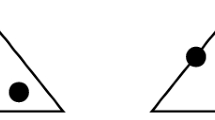Abstract
Some results concerning numerical experiments based on a variational model for quasi-static Griffith-type brittle fracture are presented. The analysis is essentially based on a formulation of variational fracture given by Francfort and Marigo, the main difference being the fact that we rely on local rather than on global minimization. Propagation of fracture is obtained by minimizing, in a step by step process, a form of energy that is the sum of bulk and interface terms. To solve the problem numerically we adopt discontinuous finite elements based on variable meshes and search for the minima of the energy through descent methods. In order to get out of small energy wells, a mesh dependent relaxation of the interface energy, tending to the Griffith limit as the mesh size tends to zero, is adopted. The relaxation consists in a carefully tailored cohesive type approximation of the interface energy tuned by few parameters. The role of such parameters is investigated.
Similar content being viewed by others
References
Ambrosio L (1989) Compactness theorem for a special class of functions of bounded variation. Boll Un Mat Ital 3-B: 857–881
Angelillo M, Babilio E, Fortunato A (2005) A numerical method for fracture of rods. In: Fremond M, Maceri F (eds) Mechanical modelling and computational issues in civil engineering. Lecture Notes in Applied and Computational Mechanics, Vol 23, Springer, Berlin, pp 277–292
Angelillo M, Babilio E, Fortunato A (2002) Numerical experiments on fracture of elastic solids through energy minimization. In: E. M. Croitoro (ed) Proc. of 2nd CanCNSM, Vancouver, Canada, pp. 181–186
Angelillo M, Babilio E, Cardamone L, Fortunato A, Lippiello M (2010) Numerical experiments in 2D variational fracture. Frattura ed Integrità Strutturale 12: 63–78
Babilio E (2003) Numerical applications of free discontinuity problems to folding and fracture. PhD Thesis, University of Salerno, Italy
Bourdin B, Francfort GA, Marigo JJ (2000) Numerical experiments in revisited brittle fracture. J Mech Phys Solids 48: 797–826
Brakke KA (1999) Surface Evolver manual. Mathematics Department, Susquehanna University, Selinsgrove
Choi Y, McKenna PJ (1993) A mountain pass method for the numerical solution of semilinear elliptic problems. Nonlinear Anal 20(4): 417–437
De Giorgi E, Ambrosio L (1988) Un nuovo tipo di funzionale del calcolo delle variazioni. Atti Accad Naz Lincei Rend Cl Sci Fis Mat Nat 82(8): 199–210
Dolbow J, Moës N, Belytschko T (2001) An extended finite element method for modeling crack growth with frictional contact. Comp Meth Appl Mech Eng 190: 6825–6846
Francfort GA, Marigo JJ (1998) Revisiting brittle fracture as an energy minimization problem. J Mech Phys Solids 46(8): 1319–1342
Fries TP, Belytschko T (2010) The generalized/extended finite element method: An overview of the method and its applications. Int J Numer Methods Eng 84: 253–304
Horák J, Lord GJ, Peletier MA (2006) Numerical Mountain Pass and its Applications. PAMM Proc Appl Math Mech 6: 10–17
Larsen CJ (2010) Epsilon-stable quasi-static brittle fracture evolution. Comm Pure Appl Math 63: 630–654
Moës N, Dolbow J, Belytschko T (1999) A finite element method for crack growth without remeshing. Int J Numer Methods Eng 46: 131–150
Soane AM, Suri M, Rostamian R (2010) The optimal convergence rate of a finite element method for non–smooth domains. J Comp App Math 233: 2711–2723
Author information
Authors and Affiliations
Corresponding author
Rights and permissions
About this article
Cite this article
Angelillo, M., Babilio, E. & Fortunato, A. Numerical solutions for crack growth based on the variational theory of fracture. Comput Mech 50, 285–301 (2012). https://doi.org/10.1007/s00466-012-0755-1
Received:
Accepted:
Published:
Issue Date:
DOI: https://doi.org/10.1007/s00466-012-0755-1




